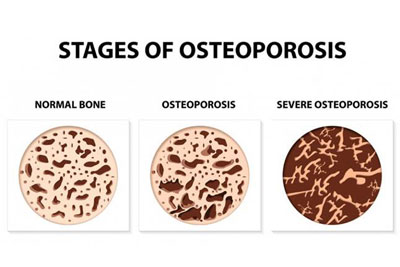
What is osteoporosis?Osteoporosis is a progressive disease that causes bones to become thin and brittle, making them more likely to break. Osteoporosis may result in broken bones in the spine and hip. Hip fractures often require hospitalization, and fractures of the bones in the spine (vertebrae) can cause loss of height and severe back pain. Both may lead to permanent disability.
Who is at risk?
Whether you develop osteoporosis depends on the thickness of your bones early in life, as well as health, diet, and physical activity later in life.
Factors that increase the risk of osteoporosis in both men and women include:
Non-Modifiable Risk Factors
•Having a family history of osteoporosis
•Menopausal women 65 or older regardless of risk factors
•Estrogen deficient women at clinical risk
•Personal history of fragilitly fracture
•Being small-framed or thin (weight less than 127 lb)
Having certain medical conditions
•Rheumatoid arthritis
•Endrinopathies( Hypercalcuira, Hyperparathyroidism, Hyperthyroidism, Cushing’s syndrome)
•Malabsorption (Gastrectomy, IBS, Celiac disease, Intestinal bypass, Pancreatic insufficiency, Primary biliary chirrhosis)
•Marrow-based and neoplastic disorders (Multiple Myeloma, hemoglobinopathies, hemolytic anemia, skeletal metastases)
•Inherited disorders (Osteogenesis imperfecta, Marfan’;s syndrome, Homocystinuria)
•Osteomalacia
•Organ Transplants
Taking certain medications
•Corticosteroids for a period of 6 months or longer
•Heparin
•Phenytoin
•Phenobarbital
•Cyclosporin
•Tetracycline
•Rifampin
•Exchange resins
•Some hormone treatments for endometriosis
•Aromatase inhibitors, used to treat breast cancer
•Thyroid replacement medication, if the dose is more than the body needs.
•Greater than 2 year use of Depo-Provera
•Antacids that contain aluminum, if they are overused.
Modifiable Risk Factors Lifestyle Factors Include:
•Smoking
•Heavy Alcohol use
•Getting little or no exercise
•A diet low in foods containing calcium, phosphorus, and vitamin D
•Cola soft drinks
•Anorexia
Testing for Osteoporosis
DEXA scan measures the bone density in the spine, total hip, and femoral neck. It compares your bone density to women at their peak bone mass (ages 25-30) and develops a bell curve comparison.
Normal: Women whose bone density is at the same or up to -1 Standard Deviation away from women at their peak bone mass are considered normal.
Osteopenia: Women whose bone density is -1.0 to -2.5 Standard Deviations away from women at their peak bone mass are considered Osteopenic. This translates to increased risk of fracture at these sites.
Osteoporosis: Women whose bone density is -2.5 or more Standard Deviations away from women at their peak bone mass are considered Osteoporotic and should consider treatment to reduce their risk of fracture.
Treatment for Osteoporosis
•Calcium 1200-1500 mg/d
•Vitamin D 800 IU/d
•Weight bearing exercise (ie. Walking, jogging, small hand weights and aerobics)
•D/C smoking and alcohol abuse
•Possible Estrogen replacement
•Possible Bisphosphonate
Contact your physician to find out further information, ask questions, or to see if certain medications may be right for you.
